steering TOYOTA SUPRA 1995 Service Repair Manual
[x] Cancel search | Manufacturer: TOYOTA, Model Year: 1995, Model line: SUPRA, Model: TOYOTA SUPRA 1995Pages: 2543, PDF Size: 53.25 MB
Page 86 of 2543
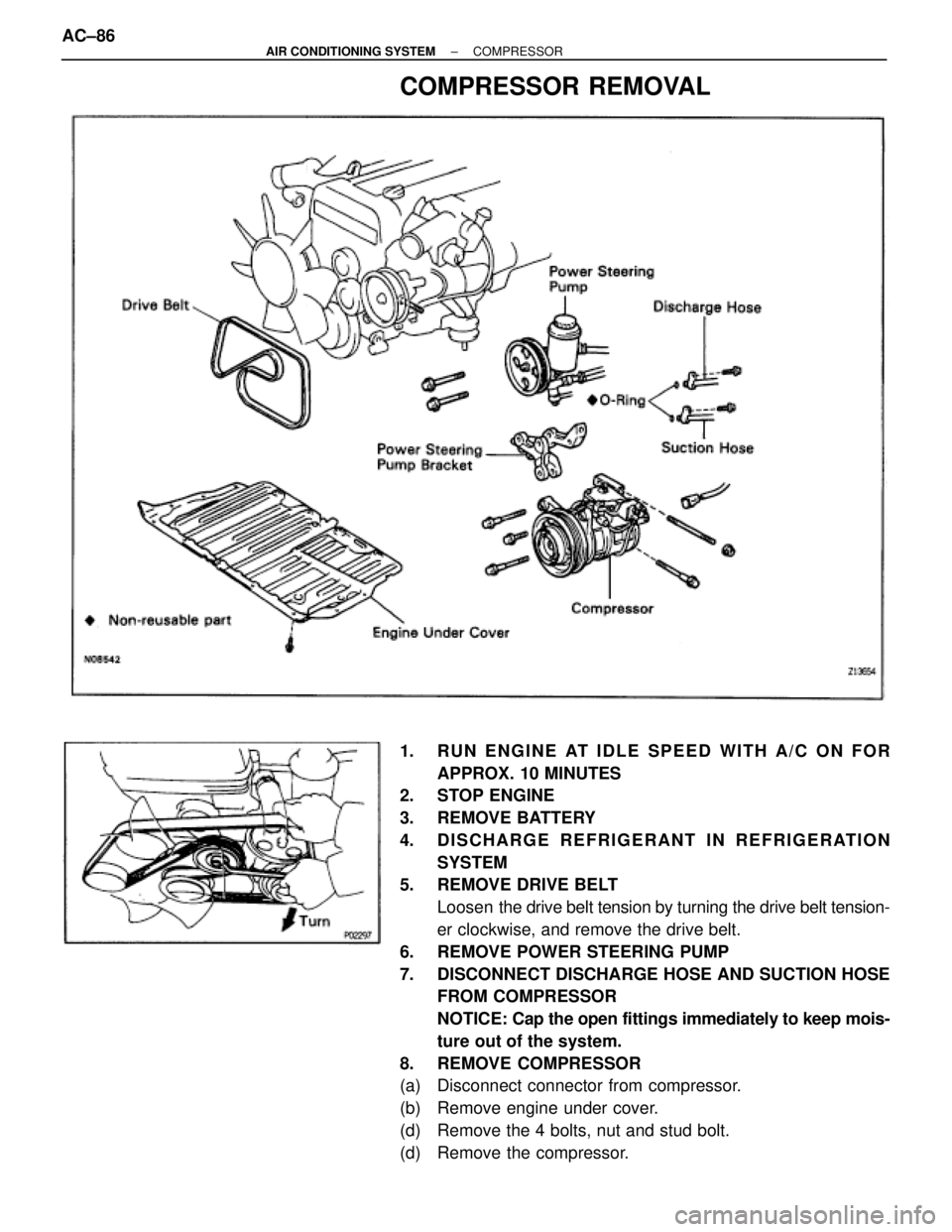
COMPRESSOR REMOVAL
1. RUN ENGINE AT IDLE SPEED WITH A/C ON FOR
APPROX. 10 MINUTES
2. STOP ENGINE
3. REMOVE BATTERY
4. DISCHARGE REFRIGERANT IN REFRIGERATION
SYSTEM
5. REMOVE DRIVE BELT
Loosen the drive belt tension by turning the drive belt tension-
er clockwise, and remove the drive belt.
6. REMOVE POWER STEERING PUMP
7. DISCONNECT DISCHARGE HOSE AND SUCTION HOSE
FROM COMPRESSOR
NOTICE: Cap the open fittings immediately to keep mois-
ture out of the system.
8. REMOVE COMPRESSOR
(a) Disconnect connector from compressor.
(b) Remove engine under cover.
(d) Remove the 4 bolts, nut and stud bolt.
(d) Remove the compressor. AC±86
± AIR CONDITIONING SYSTEMCOMPRESSOR
Page 90 of 2543

(c) Check the clearance between the pressure plate and rotor,
then connect the negative (±) terminal of the battery.
Standard clearance:
0.5 + 0.15 mm (0.020 + 0.0059 in.)
If the clearance is not within specification, adjust the clear-
ance using shims to obtain the standard clearance.
Shim Thickness:
0.1 mm (0.004 in.)
0.3 mm (0.012 in.)
0.5 mm (0.020 in.)
COMPRESSOR INSTALLATION
1. INSTALL COMPRESSOR
(a) Install the stud bolt.
Torque: 26 NVm (265 kgfVcm, 19 ftVlbf)
(b) Install the compressor with 4 bolts and nut.
Torque: 52 NVm (530 kgfVcm, 38 ftVlbf)
(c) Connect the magnetic clutch connector.
(d) Install the engine under cover.
2. CONNECT DISCHARGE HOSE AND SUCTION HOSE TO
COMPRESSOR
NOTICE: Hoses should be connected immediately after
the caps have been removed.
Torque: 10 NVm (100 kgfVcm, 7 ftVlbf)
3. INSTALL POWER STEERING PUMP
Install the power steering pump with 2 bolts.
Torque: 58 NVm (590 kgfVcm, 43 ftVlbf)
4. INSTALL DRIVE BELT
5. INSTALL BATTERY
6. EVACUATE AIR IN REFRIGERATION SYSTEM AND
CHARGE WITREFRIGERANT
Specified amount:
700 + 50 g (24.96 + 1.76 oz.)
7. INSPECT FOR LEAKAGE OF REFRIGERANT
Using a gas leak tester, check for leakage of refrigerant.
If there is leakage, check the tightening torque at the joints.
8. INSPECT A/C OPERATION AC±90
± AIR CONDITIONING SYSTEMCOMPRESSOR
Page 119 of 2543
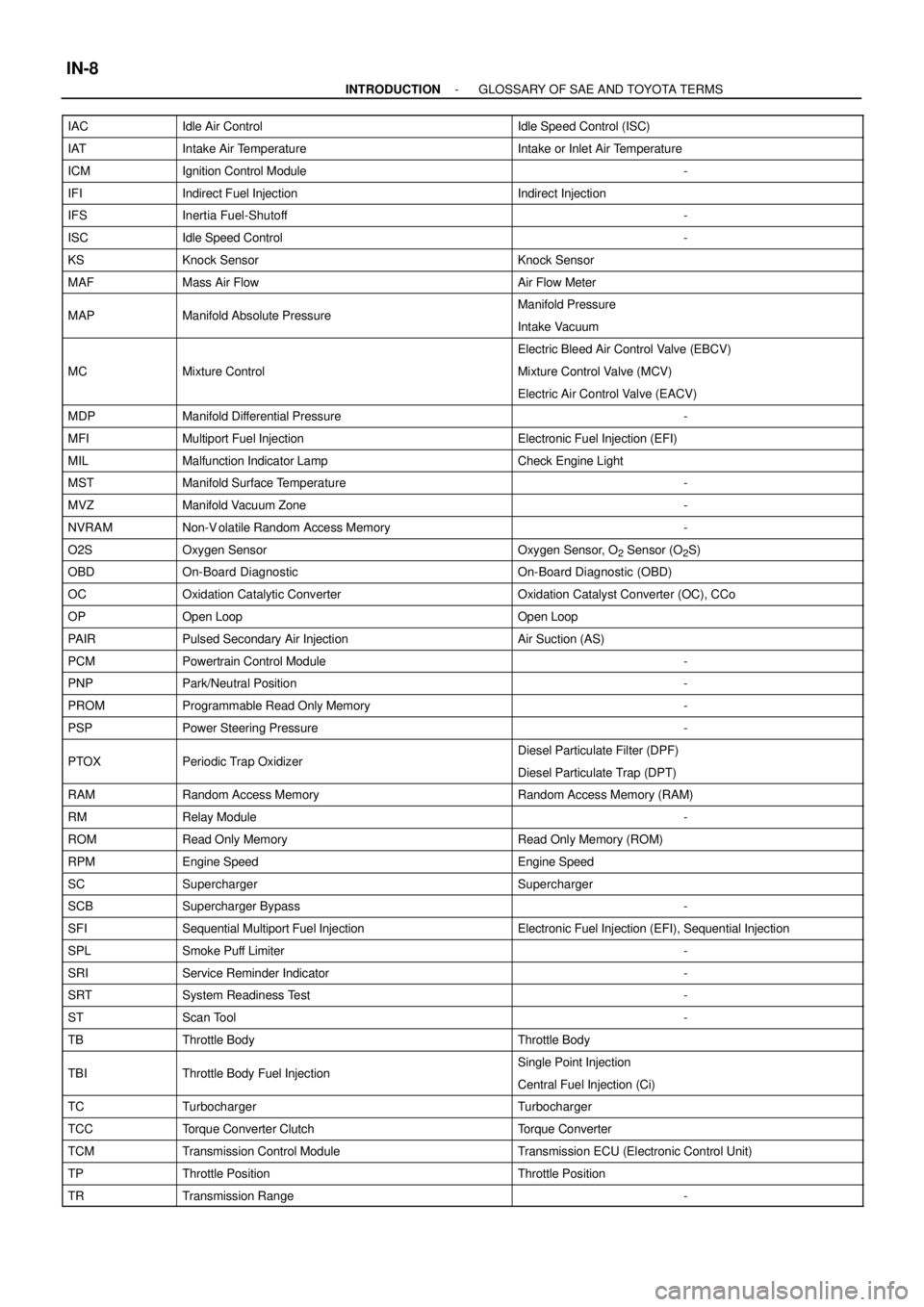
INTRODUCTIONGLOSSARY OF SAE AND TOYOTA TERMS -
IN-8
IACIdle Air ControlIdle Speed Control (ISC)
IATIntake Air TemperatureIntake or Inlet Air Temperature
ICMIgnition Control Module-
IFIIndirect Fuel InjectionIndirect Injection
IFSInertia Fuel-Shutoff-
ISCIdle Speed Control-
KSKnock SensorKnock Sensor
MAFMass Air FlowAir Flow Meter
MAPManifold Absolute PressureManifold Pressure
Intake Vacuum
MCMixture Control
Electric Bleed Air Control Valve (EBCV)
Mixture Control Valve (MCV)
Electric Air Control Valve (EACV)
MDPManifold Differential Pressure-
MFIMultiport Fuel InjectionElectronic Fuel Injection (EFI)
MILMalfunction Indicator LampCheck Engine Light
MSTManifold Surface Temperature-
MVZManifold Vacuum Zone-
NVRAMNon-V olatile Random Access Memory-
O2SOxygen SensorOxygen Sensor, O2 Sensor (O2S)
OBDOn-Board DiagnosticOn-Board Diagnostic (OBD)
OCOxidation Catalytic ConverterOxidation Catalyst Converter (OC), CCo
OPOpen LoopOpen Loop
PAIRPulsed Secondary Air InjectionAir Suction (AS)
PCMPowertrain Control Module-
PNPPark/Neutral Position-
PROMProgrammable Read Only Memory-
PSPPower Steering Pressure-
PTOXPeriodic Trap OxidizerDiesel Particulate Filter (DPF)
Diesel Particulate Trap (DPT)
RAMRandom Access MemoryRandom Access Memory (RAM)
RMRelay Module-
ROMRead Only MemoryRead Only Memory (ROM)
RPMEngine SpeedEngine Speed
SCSuperchargerSupercharger
SCBSupercharger Bypass-
SFISequential Multiport Fuel InjectionElectronic Fuel Injection (EFI), Sequential Injection
SPLSmoke Puff Limiter-
SRIService Reminder Indicator-
SRTSystem Readiness Test-
STScan Tool-
TBThrottle BodyThrottle Body
TBIThrottle Body Fuel InjectionSingle Point Injection
Central Fuel Injection (Ci)
TCTurbochargerTurbocharger
TCCTorque Converter ClutchTorque Converter
TCMTransmission Control ModuleTransmission ECU (Electronic Control Unit)
TPThrottle PositionThrottle Position
TRTransmission Range-
Page 453 of 2543

INSPECTION PROCEDURE
Shift the shift lever to N position.
Jack up one of the rear wheels.
Connect the Check Harness A
(See page EG±404)
Disconnect power steering ECU connector
and cruise control ECU connector.
Turn ignition switch ON.
Measure voltage between terminal SP1 of ECM
connector and body ground when the wheel is
turned slowly.
Check voltage between terminal SP1 of ECM connector and body ground.
Voltage is generated intermittently.
Check and replace ECM.
Repair or replace harness or connector be-
tween ECM and telltale light RH.
Check operation of odometer and trip meter (telltale light RH (See page
BR±48))
AT1±67± AT340E (2JZ±GE) AUTOMATIC TRANSMISSIONTROUBLESHOOTING
Page 557 of 2543
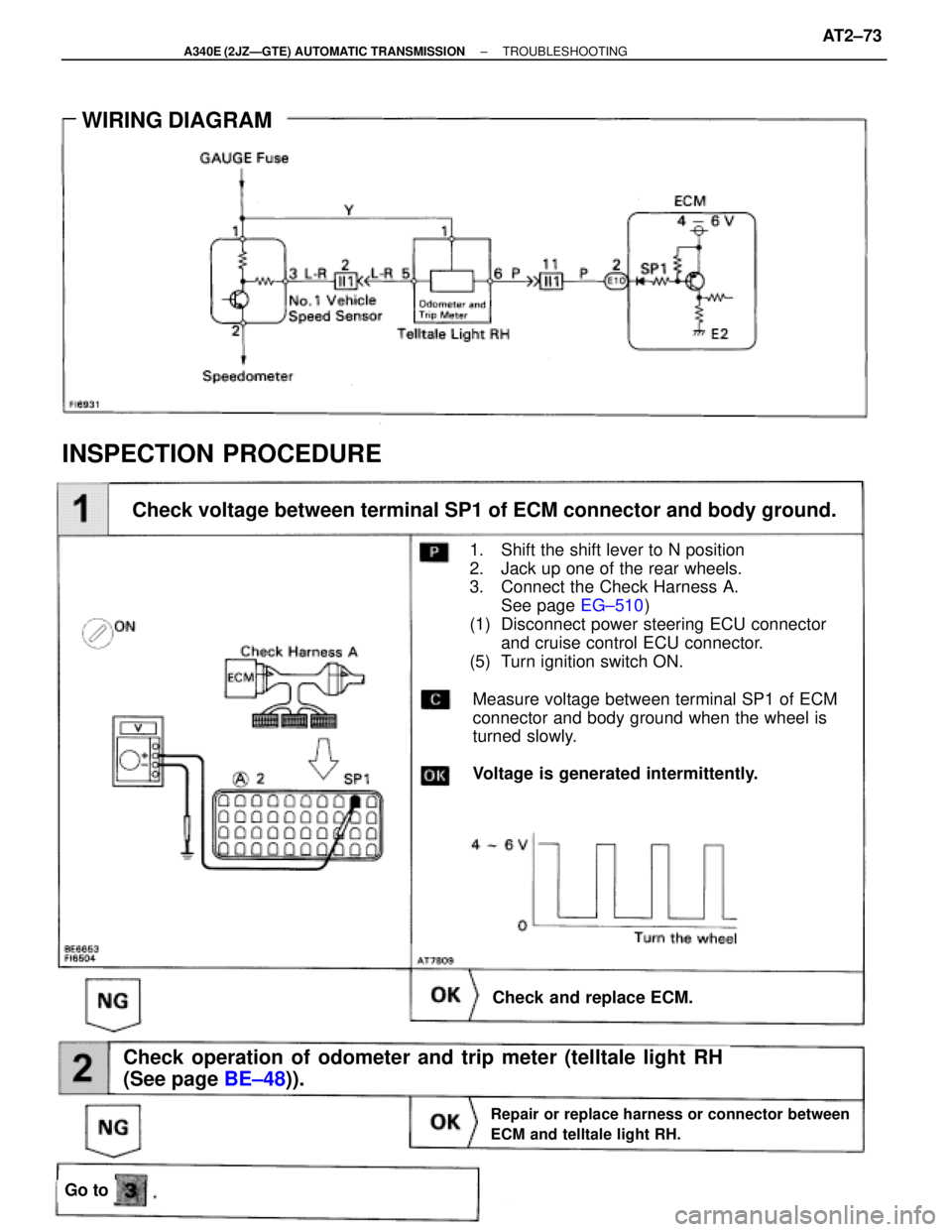
WIRING DIAGRAM
Check voltage between terminal SP1 of ECM connector and body ground.
Check operation of odometer and trip meter (telltale light RH
(See page BE±48)).
Check and replace ECM.
Repair or replace harness or connector between
ECM and telltale light RH.
Go to
1. Shift the shift lever to N position
2. Jack up one of the rear wheels.
3. Connect the Check Harness A.
See page EG±510)
(1) Disconnect power steering ECU connector
and cruise control ECU connector.
(5) Turn ignition switch ON.
Measure voltage between terminal SP1 of ECM
connector and body ground when the wheel is
turned slowly.
Voltage is generated intermittently.
INSPECTION PROCEDURE
± A340E (2JZÐGTE) AUTOMATIC TRANSMISSIONTROUBLESHOOTINGAT2±73
Page 604 of 2543

PRECAUTION
Take care to observe the doing precautions when performing inspections or removal and replacement of
body electrical related parts.
HEADLIGHT SYSTEM
wHalogen bulbs have pressurized gas inside and require special handling. They can burst if scratched or
dropped. Hold a bulb only by its plastic or metal case.
Don't touch the glass part of a bulb with bare hands.
SRS (SUPPLEMENTAL RESTRAINT SYSTEM)
wWork must be started after 90 seconds from the time the ignition switch is turned to the ºLOCKº position
and the negative (±) terminal cable is disconnected from the battery.
wWhen disconnecting any of the connectors in the SRS, be sure to lock the ignition switch and disconnect
the negative (±) terminal cable from the battery first. Since the connectors are twin lock type connectors,
disconnect the connectors only after releasing the first stage lock.
wWhen connecting SRS connectors, be sure to lock them securely. (If the connectors are not locked
securely, the system may not operate when needed.)
wAlways store the steering wheel pad with the pad surface facing upward. (Storing the pad with its metallic
surface up may lead to a serious accident if the SRS inflates for some reason.)
wWhen installing the spiral cable, be sure the vehicle is in the straight ahead condition and confirm that the
spiral cable is in the neutral position when it is installed.
wINFORMATION LABELS (NOTICE) are attached to the periphery of the SRS components. Follow the
NOTICE.
AUDIO SYSTEM
wIf the negative (±) terminal cable is disconnected from the battery, the preset AM, FM 1 and FM 2 stations
stored in memory are erased, so be sure to note the stations and reset them after the battery terminal is
reconnected.
wIf the negative (±) terminal cable is disconnected from the battery, the ºANTI±THEFT SYSTEMº will operate
when the cable is reconnected, but the radio, tape player and CD player will not operate. Be sure to input
the correct ID number so that the radio, tape player and CD player can be operated again.
MOBILE COMMUNICATION SYSTEM
wIf the vehicle is equipped with a mobile communication system, refer to precautions in the IN section. BE±2
± BODY ELECTRICAL SYSTEMPRECAUTION
Page 783 of 2543
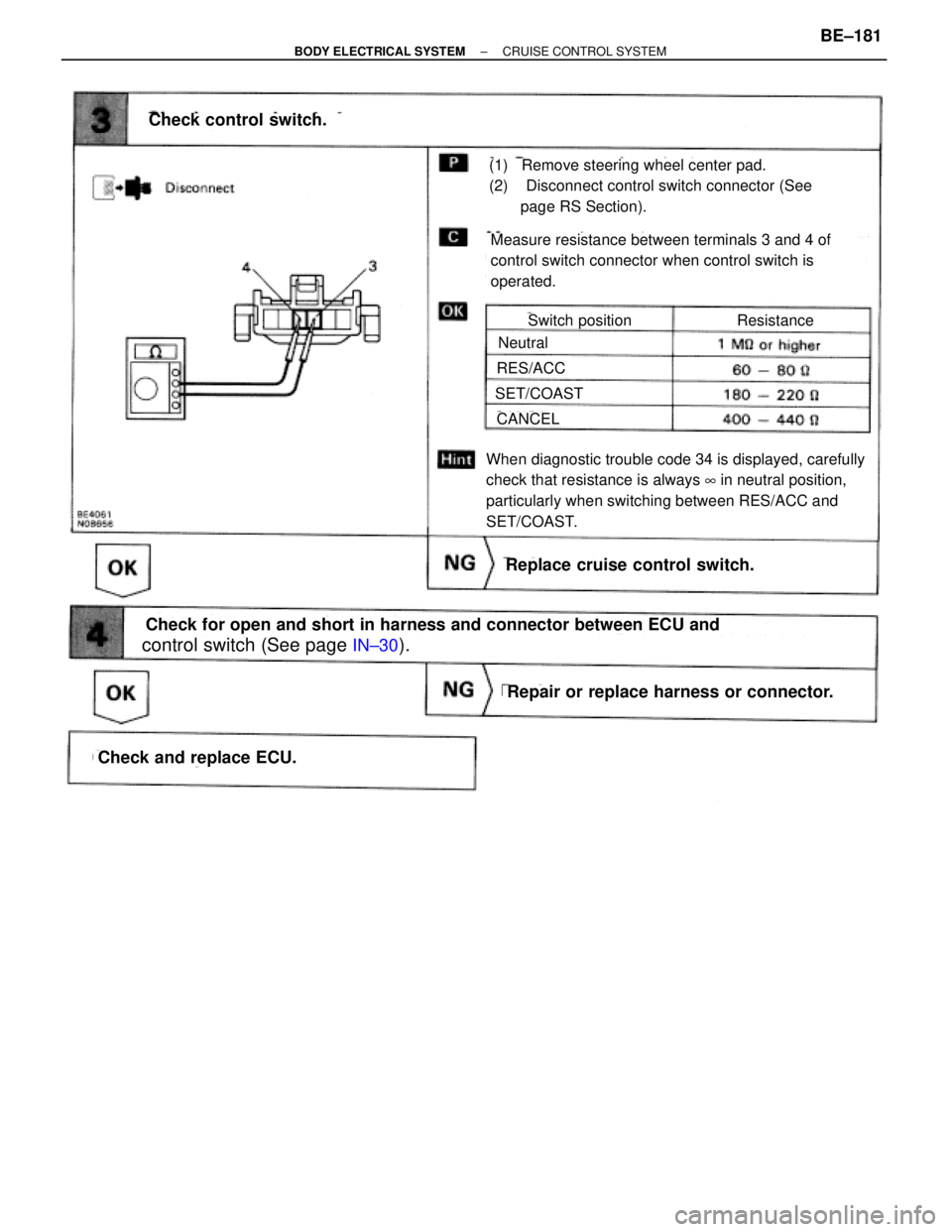
control switch (See page IN±30).
Switch position
Neutral
RES/ACC
SET/COAST
CANCEL
Replace cruise control switch.
Measure resistance between terminals 3 and 4 of
control switch connector when control switch is
operated.
Repair or replace harness or connector.
Check and replace ECU.
When diagnostic trouble code 34 is displayed, carefully
check that resistance is always 8 in neutral position,
particularly when switching between RES/ACC and
SET/COAST.
(1) Remove steering wheel center pad.
(2) Disconnect control switch connector (See
page RS Section).
Check control switch.
Check for open and short in harness and connector between ECU and
Resistance
± BODY ELECTRICAL SYSTEMCRUISE CONTROL SYSTEMBE±181
Page 800 of 2543
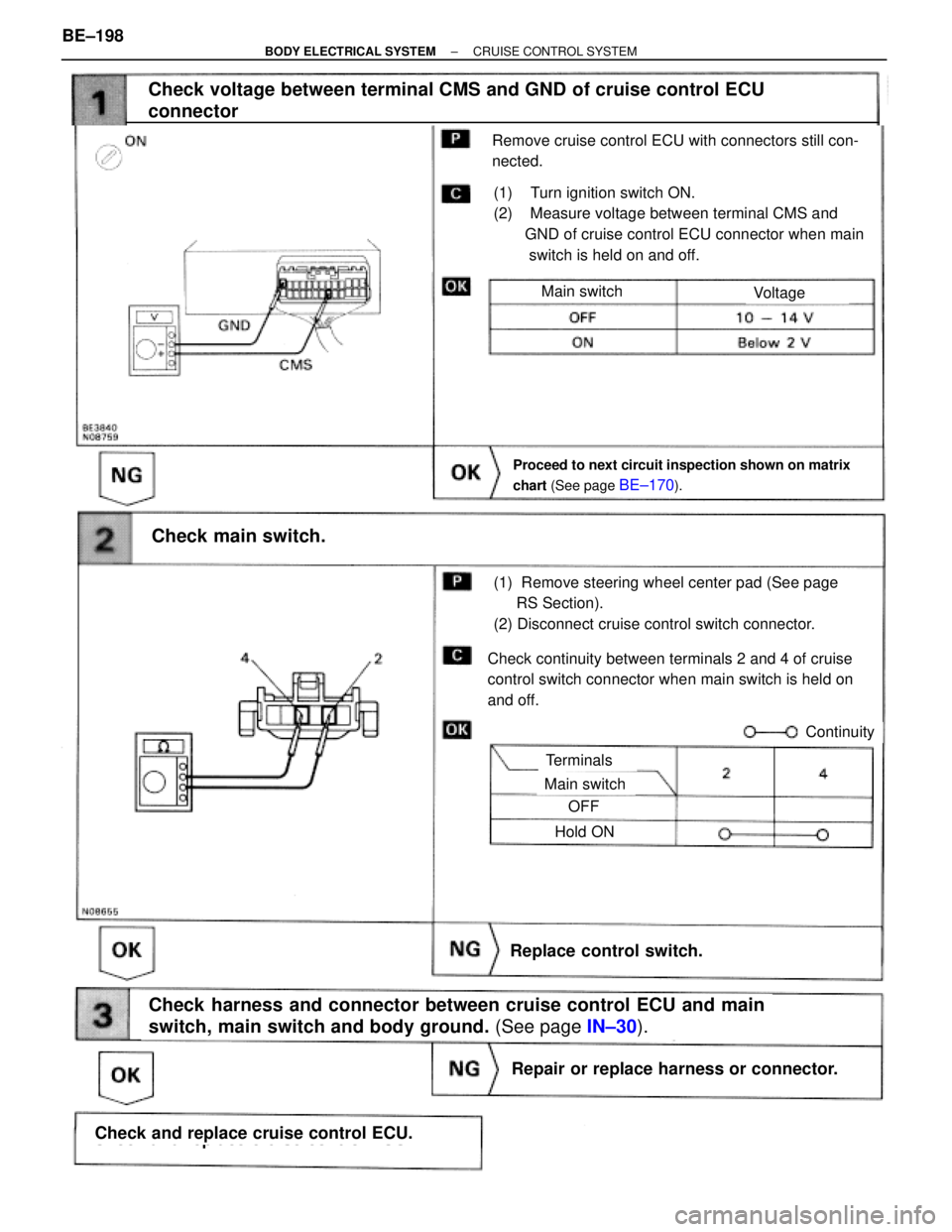
Check harness and connector between cruise control ECU and main
switch, main switch and body ground. (See page IN±30).
Proceed to next circuit inspection shown on matrix
chart (See page
BE±170).
(1) Turn ignition switch ON.
(2) Measure voltage between terminal CMS and
GND of cruise control ECU connector when main
switch is held on and off.
Remove cruise control ECU with connectors still con-
nected.
Main switch
Repair or replace harness or connector.
Check and replace cruise control ECU.
Voltage
Check continuity between terminals 2 and 4 of cruise
control switch connector when main switch is held on
and off.
(1) Remove steering wheel center pad (See page
RS Section).
(2) Disconnect cruise control switch connector.
Terminals
Main switch
OFF
Hold ON
Continuity
Check main switch.
Repair or replace harness or connector.
Check and replace cruise control ECU.
Replace control switch.
Check voltage between terminal CMS and GND of cruise control ECU
connector
BE±198± BODY ELECTRICAL SYSTEMCRUISE CONTROL SYSTEM
Page 810 of 2543

SRS (Supplemental Restraint System)
The 1995 SUPRA is equipped with an SRS, such as the driver airbag and front passenger airbag assembly.
Failure to carry out service operations in the correct sequence could cause the SRS to deploy, possibly
leading to a serious accident.
When removing or installing of airbag parts and the yellow wire harness and connector for the airbag is
necessary, refer to the precautionary notices in the RS section before performing the operation.
wWork must be started after 90 seconds from the time the ignition switch is set to the LOCK position
and the negative (±) terminal cable is disconnected from the battery.
(The SRS is equipped with a back±up power source so that if work is started within 90 seconds of
disconnecting the negative (±) terminal cable of the battery, the SRS may deploy.)
wTo avoid erasing the memory of each memory system, never use a back±up power supply from
outside the vehicle.
wBefore repairs, remove the airbag sensors if shocks are likely to be applied to the sensors during
repairs.
wThe front airbag sensor set bolt has been anti±rust treated. When the sensor is removed, always
replace the set bolt with a new one.
wIf the front airbag sensors, center airbag sensor assembly, steering wheel pad or front passenger
airbag assembly have been dropped, or if there are cracks, dents or other defects in the case, bracket
or connector, replace them with new ones.
wNever use SRS parts from another vehicle. When replacing parts, replace them with new parts.
wDo not expose the front airbag sensors, center airbag sensor assembly, steering wheel pad or front
passenger airbag assembly directly to hot air or flames.
wThe SRS wire harness is integrated with the cowl wire harness assembly. The wires for the SRS wire
harness are encased in a yellow corrugated tube. All the connectors for the system are also a standard
yellow color. If the SRS wire harness becomes disconnected or the connector becomes broken due
to an accident, etc., repair or replace it. (See RS section)
wThe steering wheel must be fitted correctly to the steering column with the spiral cable at the neutral
position; otherwise, cable disconnection and other troubles may result. Refer to RS section of this
manual concerning correct steering wheel installation.
wWhen removing or handling the steering wheel pad or front passenger airbag assembly, it should be
placed with their top surface facing up. In this case, the twin±lock type connector lock lever should
be in the locked state and care should be taken to place it so the connector will not be damaged.
(Storing the pad with its metallic surface up, the front passenger airbag assembly with the airbag door
facing down may lead to a serious accident if the airbag inflates for some reason.)
wGrease should not be applied to the steering wheel pad or the front passenger airbag assembly, and
they should not be cleaned with detergents of any kind.
wStore the steering wheel pad or the front passenger airbag assembly where the ambient temperature
remains below 93°C (200°F), without high humidity and away from electrical noise.
wInformation labels are attached to the periphery of the SRS components. Follow the notices.
wWhen the ignition switch is at ACC or ON and the SRS warning light remains on, the center airbag
sensor assembly has detected a malfunction code. (See RS section)
± BODYGENERAL INFORMATIONBO±5
Page 853 of 2543
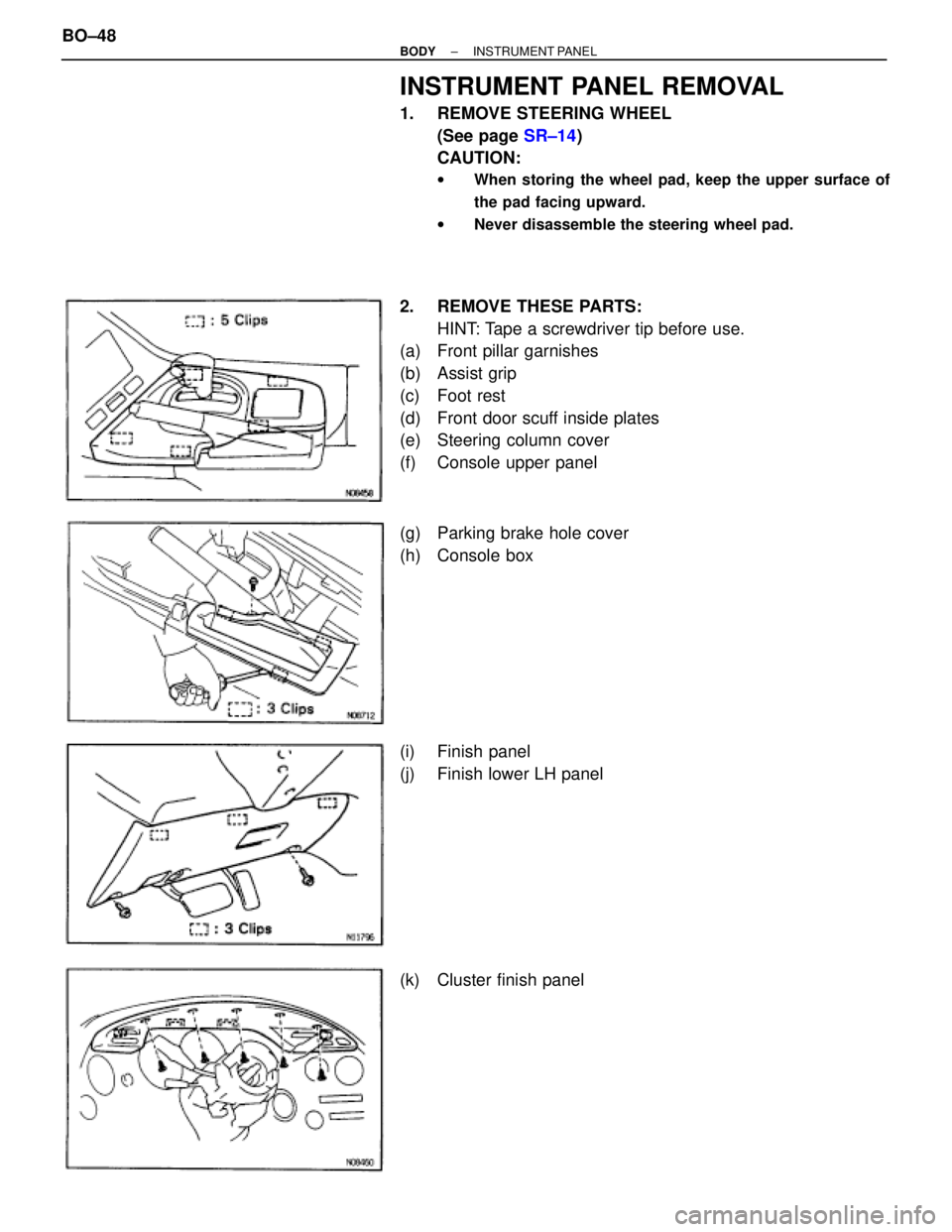
INSTRUMENT PANEL REMOVAL
1. REMOVE STEERING WHEEL
(See page SR±14)
CAUTION:
wWhen storing the wheel pad, keep the upper surface of
the pad facing upward.
wNever disassemble the steering wheel pad.
2. REMOVE THESE PARTS:
HINT: Tape a screwdriver tip before use.
(a) Front pillar garnishes
(b) Assist grip
(c) Foot rest
(d) Front door scuff inside plates
(e) Steering column cover
(f) Console upper panel
(g) Parking brake hole cover
(h) Console box
(i) Finish panel
(j) Finish lower LH panel
(k) Cluster finish panel BO±48
± BODYINSTRUMENT PANEL